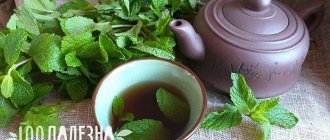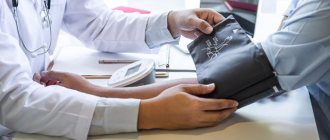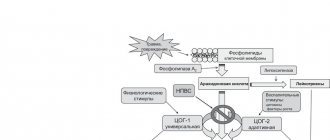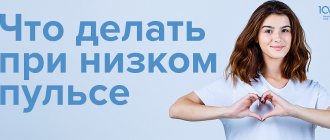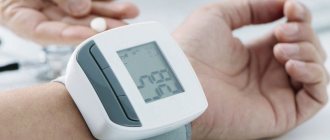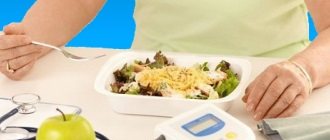High blood pressure, a problem that everyone has heard of. But low blood pressure also occurs quite often, even in young people. If with hypertension everything is more or less clear, there is a clear gradation of numbers, then with hypotension it is not possible to focus only on numbers. One person feels great with a blood pressure of 90/60, but feels unwell when the pressure rises to 120/60. Another person with low blood pressure feels weak and lacks strength.
What it is
Reduced blood pressure is considered to be less than 100/60 mmHg. Art. Sometimes this may be physiological hypotension, which does not cause deterioration in well-being. Such individual characteristics can be caused by heredity and a person’s physique. They are also found among residents of high mountain regions, tropics, and athletes. A person usually finds out about this by accident and has no complaints1.
If low blood pressure is accompanied by symptoms of malaise, we can talk about pathology. Often, episodes of low blood pressure begin in childhood and adolescence as manifestations of neurocirculatory dystonia. Then they become regular and can develop into chronic arterial hypotension2.
If arterial hypotension is a consequence of other diseases, it is necessary to carry out treatment aimed at these problems. What can cause low blood pressure:
- anemia;
- chronic diarrhea;
- severe varicose veins, which leads to retention of a large volume of blood in the lower extremities;
- consequences of taking diuretics, antihypertensive drugs, barbiturates, antidepressants;
- adrenal insufficiency;
- tonsillitis;
- gastritis, peptic ulcer;
- diseases of the liver and biliary tract;
- heart diseases.
There are many reasons, so a medical examination and examination is required to establish the correct diagnosis.
Sometimes such an unusual combination of hypotension in an upright position with hypertension in a supine position is detected. Since blood pressure is usually measured while sitting, hypertension may not be detected immediately.
To establish a correct diagnosis, a medical examination and examination is required.
Ways to solve the problem at home
In case of fainting, first aid should be provided immediately. It is important to quickly stop the decrease in blood pressure and help the person cope with the serious condition. To do this you need:
How to increase blood pressure using folk remedies
- lay the person down so that the legs are higher than the level of the head, which will restore cerebral circulation;
- ensure a flow of fresh air by freeing your neck from clothing and opening the windows in the room;
- bring a cotton swab dipped in ammonia to your nose, which will allow you to regain consciousness thanks to the sharp and unpleasant smell;
- after regaining consciousness, the person should sit quietly for at least 10 minutes;
- You can increase glucose with a piece of refined sugar or chocolate.
The following antihypertensive drugs are widely used for low blood pressure: Dobutamine, Caffeine, Citramon, Mezaton. They help normalize blood pressure and reduce the frequency of attacks of hypotension. However, they should be taken only after measuring blood pressure, since there are often situations when a hypotensive patient’s blood pressure has increased, and conventional medications can provoke a sharp jump in blood pressure.
Adaptogens of plant origin, for example, Chinese schisandra extract, have a pronounced antihypotensive effect on the body
Advice! If your blood pressure drops regularly, make it a rule to carry glucose with you in tablet form. A few tablets, sold at any pharmacy, will help you quickly and safely cope with weakness and headaches.
Symptoms of hypotension
The symptoms that occur are usually caused by a lack of blood supply to the brain and heart. Here are typical manifestations1:
- headache;
- dizziness, imbalance;
- nausea;
- severe weakness;
- memory impairment;
- decreased performance;
- intolerance to bright light, harsh sounds, stuffiness.
Deterioration in health is accompanied by pain in the heart, rapid or slow heartbeat, and rhythm disturbances.
As soon as such a person gets out of bed in the morning and starts walking, he feels worse due to an even greater decrease in blood pressure, so he wants to go back to bed. Additional symptoms:
- coldness and impaired sensitivity of the extremities (fingers);
- symptoms worsen due to fatigue, stress, lack of sleep, acute infections and exacerbation of any chronic diseases.
Preventive measures
Signs of primary hypotension are easily eliminated, so there is no need to panic if your blood pressure drops. It is important to know how to increase blood pressure when it drops sharply and follow the rules of prevention, which boil down to the following:
- do exercises in the morning;
- spend more time in the fresh air;
- take vitamins;
- ensure yourself healthy sleep;
- eat rationally;
- drink enough liquid, especially in the hot season;
- try not to be nervous;
- control your weight;
- do acupressure.
How to raise blood pressure
Oddly enough, drinking coffee and tea in the morning is not recommended, but it is better to avoid it altogether. The desire to get a “charge of vigor” in the morning first becomes a habit, and then turns into doping and requires a constant increase in the dose1.
Moderate loads with a smooth increase in duration have a positive effect. For example, walking, exercise bike, gentle jogging, skiing, swimming.
Static loads with a forced posture (working at a computer), tilting the head, lifting heavy objects are best avoided. If it is impossible to alternate them with physical activity.
In the morning, you need to learn to get up slowly so as not to cause a drop in blood pressure. Compression stockings on your legs may also help. It will reduce the amount of blood in the veins of the lower extremities. For training, you can sleep with the head of the bed elevated.
It is better to avoid static loads with a forced posture
General recommendations for nutrition for hypotensive patients
With hypotension, it is important to adjust both the diet and diet. There are several eating habits that contribute to high blood pressure:
- Eat more often, but in small portions. This will ensure a constant supply of energy and high tone.
- Drink more water. When dehydrated, the volume of circulating blood decreases and blood pressure drops. If a person drinks enough water, the blood volume will be larger and the blood pressure will be higher. You need to additionally increase the volume of fluid you drink in hot weather and during physical activity.
- Don't skip meals. Such omissions can provoke overeating, which will cause blood pressure to drop.
- Reduce alcohol consumption. It causes dehydration and may worsen hypotension.
To improve your health with hypotension, you need to change your diet as follows:
- Get enough salt from food. Hypotonic people can eat dishes with added sea or table salt, as well as canned vegetables, cheeses, and salted fish. This will help retain fluid in the body and increase blood volume to increase blood pressure. In this case, total salt consumption should not exceed 5 g per day.
- Drink caffeinated drinks. It is better if it is natural coffee, black or green tea. The caffeine they contain causes heart rate to increase and blood pressure to rise. This effect is temporary. It should not be overused: if a person drinks a lot of coffee or tea, it can have a bad effect on heart health. In addition, over time, tolerance to caffeine may develop, and it will no longer provide a tonic effect.
- Get more vitamin B9 and B12 from foods. Hypotension may be associated with anemia caused by a deficiency of B vitamins. Hypotonic people need to eat more foods containing vitamin B12 (fish, chicken, eggs, low-fat dairy products) and B9 (broccoli, asparagus, lentils and chickpeas, liver).
- Control your carbohydrate intake. If your diet contains a lot of foods containing carbohydrates, this can have a bad effect on your heart condition and cause anemia. In addition, such foods are quickly digested, after which the pressure drops sharply. To reduce the symptoms of anemia, you need a balanced diet. It should not be overloaded with foods containing easily digestible carbohydrates (sweets, starchy foods, sweet vegetables, fruits and dried fruits, foods and drinks with added sugar).
In addition to nutrition, healthy habits such as good sleep and exercise are important (Figure 2).
Figure 2. General recommendations for hypotensive patients. Source: MedPortal
List of foods you can eat for hypotension
Hypotonic people can eat almost any food, but it is important that the diet remains balanced. The menu can include:
- fresh vegetables and salads made from them with added salt (but it is better to limit the overall use of salt and control it so that it does not provoke swelling);
- boiled or baked vegetables;
- cereals;
- fruits, dried fruits in limited quantities;
- meat, poultry, fish (preferably low-fat so that the level of cholesterol in the blood does not increase);
- cheeses, dairy, fermented milk products;
- bread, pastries, sweets (in limited quantities);
- chocolate;
- coffee and other caffeinated drinks;
- eggs;
- spices, hot seasonings (including ginger, pepper).
Additional dietary restrictions may apply that are not related to high or low blood pressure. To take them all into account, it is better to create a menu together with your therapist or nutritionist.
Physiotherapeutic procedures
- Cryochamber.
- Rubbing with warm water with a gradual decrease in temperature to 10-15*C.
- Charcot/rain/circular shower.
- Turpentine, carbon dioxide, mineral baths.
- Other tonic effects.
It is most convenient to receive a set of procedures during sanatorium-resort treatment. This allows you to take your mind off the stress of everyday life, normalize your sleep and diet. Walking and a good emotional background will make an important contribution to the healing process.
Caffeamine
This drug for increasing low blood pressure is available in tablets and is sold by prescription. Belongs to the group of combined psychostimulants, the active substances are caffeine and ergotamine. “Caffetamine” tones the nervous system and constricts blood vessels.
This medicine is prescribed for migraines, hypotension and intracranial hypertension.
Among the contraindications: allergic reactions to the components of the drug, age under 18 years, atherosclerosis, high blood pressure, pregnancy and breastfeeding, insomnia, glaucoma, psychosis, serious heart disease, advanced age of the patient. Side effects: nausea, increased sweating, agitation, tachycardia.
Caffeamine
KRKA-RUS, Russia
The drug is used for: Vasoparalytic form of migraine;
arterial hypotension; as a means of lowering intracranial pressure in vascular, traumatic and infectious lesions of the central nervous system. from 151
5.0 1 review
438
- Like
- Write a review
Read also How to treat migraine: the best drugs Top 5 best drugs against migraine
Drugs
To normalize tone, it is possible to take adaptogens in courses1:
- Eleutherococcus;
- ginseng;
- Aralia;
- pantocrine;
- lemongrass
If arterial hypotension is a consequence of other diseases, it is necessary to carry out treatment aimed at these problems.
In case of adrenal insufficiency, lifelong replacement therapy may be prescribed. Depending on the type of violation, the following is used:
- glucocorticoids (cortef);
- mineralocorticoids (cortineff).
A special case and difficulty for the doctor and the patient is the combination of arterial hypotension and hypertension. Since the treatment methods are radically opposite, choosing the right treatment method is not easy.
In any case, the prescription and correction of treatment should be made by a doctor. At the same time, success in treatment cannot be achieved without the patient’s efforts.
Ekdisten
This is a herbal medicine that comes in the form of tablets and powder sachets. The active substance of the drug is a plant extract from the rhizomes of Leuzea safflower. "Ecdisten" improves overall metabolism, vascular tone, stimulates protein synthesis, and has a weak anabolic effect.
This drug is prescribed for low blood pressure, general asthenia, to improve performance and for weather dependence.
Contraindications include: age under 18 years, allergies to drug components, hypertension, nervous disorders with agitation, epilepsy, stomach ulcers. Ecdisten should be prescribed with caution to those with diabetes or thyroid disease. Alcohol is contraindicated while taking Ecdisten.
Ekdisten
Wifitech/Vilar, Russia
The drug Ecdisten is used in adults as a tonic: asthenodepressive syndrome (associated with a weakening of protein synthesizing processes: during prolonged intoxication, infections), neurasthenia. And also as part of combination therapy - arterial hypotension, intense training (dysfunction of the cardiovascular system, especially with pronounced signs of myocardial overstrain and increased protein catabolism), as a drug that increases speed and strength qualities during the period of preparation for competitions.
219
- Like
- Write a review
Apilak
This low blood pressure medicine comes in the form of sublingual tablets and ointment. "Apilak" belongs to the group of natural stimulants for the complex treatment of asthenia, neurotic disorders, and hypotension. Apilak contains a complex of biologically active substances, minerals and vitamins. The active substance is royal jelly. "Apilak" improves vascular tone, tones the nervous system and stimulates the body as a whole.
Contraindications include: allergies to bee products, age under 18 years, Addison's disease, hypertension.

